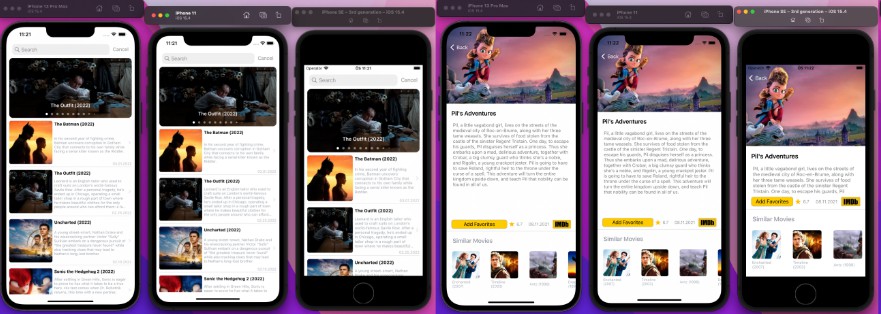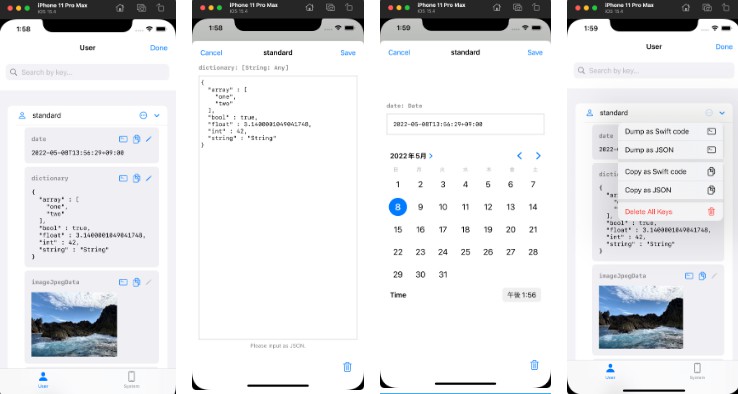Eazy
Eazy is the missing piece in your SwiftUI and UIKit application. It aims at harmonizing how your views communicate with the model and vice versa in a clear and consistent way. Eazy can be used on any Apple platform.
Eazy is a unidirectional architecture that takes a slightly different approach when it comes to mutating state. Let’s go through the core components in Eazy by looking at an example.
This example will go through a chat feature. In this feature we can post and receive new messages. Let’s start by defining the view state.
State
struct ChatState: Equatable {
struct Message: Equatable, Identifiable {
enum From: Equatable {
case other
case me
}
let id = UUID()
let from: From
let text: String
}
enum MessagesState: Equatable {
case loading
case success([Message])
case failure(String)
}
var messagesState: MessagesState = .loading
var newMessageString = ""
}
And to retrieve and send those messages we need to define some actions.
Action
enum ChatAction: Equatable {
case getMessages
case sendMessage
}
We also need to communicate with the outside world since we can recieve incoming messages. For that we can use a hook which we will call messageRecieved. Hooks can be used to observe internal state as well. Let’s add a hook named newMessageChanged for when newMessageString changes so we can make sure to save any drafts if the user exits the screen.
Hooks
enum ChatHook: CaseIterable {
case messageRecieved
case newMessageChanged
}
Dependencies
Handling dependencies is a easy as defining a struct, or use a protocol if you like.
struct ChatService {
let getMessages: () async throws -> [ChatState.Message]
let sendMessage: (ChatState.Message) async -> Void
let receivedMessage: AnyPublisher<ChatState.Message, Never>
let cacheDraft: (String) -> Void
}
Interactor
The interactor is where we decide how our state should transition. The interactor is responsible for handling our actions, both synchronous and asynchronous. For asynchronous actions we can use async await.
import Eazy
struct ChatInteractor: Interactor {
let service: ChatService
func onAction(_ action: ChatAction, store: MutatingStore<ChatState, ChatAction>) async {
switch action {
case .getMessages:
do {
store.messagesState = .loading
let messages = try await service.getMessages()
store.messagesState = .success(messages)
} catch {
store.messagesState = .failure("Something went wrong")
}
case .sendMessage:
guard !store.newMessageString.isEmpty else {
return
}
let message = ChatState.Message(from: .me, text: store.newMessageString)
await service.sendMessage(message)
store.newMessageString = ""
}
}
}
The interactor is also where we configure our hooks by using Combine publishers.
struct ChatInteractor: Interactor {
// ...
func publisher(for hook: ChatHook, store: MutatingStore<ChatState, ChatAction>) -> AnyCancellable {
switch hook {
case .messageRecieved:
return HookPublisher(service.receivedMessage)
.sink { message in
if case .success(let messages) = store.messagesState {
withAnimation {
store.messagesState = .success(messages + [message])
}
}
}
case .newMessageDraftChanged:
return HookPublisher(store.publisher.newMessageString)
.sink { newMessage in
service.cacheDraft(newMessage)
}
}
}
}
So as we can see, actions and hooks is what we use to update state.
View
This sets up a basic chat view. We encapsulate our logic into a Store. We then interact with the store by using the @StateStore property wrapper. The store behaves pretty much like any ObservableObject which means we can observe state changes and create bindings by prefixing state properties with $. We trigger actions by calling store.dispatch.
struct ChatView: View {
@StateStore var store: Store<ChatState, ChatAction>
var body: some View {
NavigationView {
VStack {
ScrollView {
switch store.messagesState {
// case .loading:
case .success(let messages):
LazyVStack {
ForEach(messages) { message in
Group {
switch message.from {
case .me:
HStack {
Spacer()
MessageView(text: message.text, color: .blue)
}
case .other:
HStack {
MessageView(text: message.text, color: .gray)
Spacer()
}
}
}
.padding(.vertical, 8)
}
}
// case .failure(let error)
}
NewMessageView(message: $store.newMessageString) {
store.dispatch(.sendMessage)
}
.padding()
}
.task {
await store.dispatch(.getMessages)
}
.navigationTitle("Conversation")
}
}
}
struct NewMessageView: View {
// ..
}
struct MessageView: View {
// ..
}
SwiftUI animations works out of the box. Let’s add a animation for when we recieve a new message.
case .messageRecieved:
return HookPublisher(service.receivedMessage)
.sink { message in
if case .success(let messages) = store.messagesState {
withAnimation {
store.messagesState = .success(messages + [message])
}
}
}
}
Now all we need to do is provide a service implementation and we are all set! Let’s create a mock for now.
extension Array where Element == ChatState.Message {
static let mock: [ChatState.Message] = [
.init(from: .me, text: "Hello my friend"),
.init(from: .other, text: "Well hello"),
.init(from: .me, text: "Protein, iron, and calcium are some of the nutritiona benefits associated with cheeseburgers."),
]
}
extension ChatService {
static var mock: Self {
let subject = PassthroughSubject<ChatState.Message, Never>()
return ChatService(
getMessages: {
try await Task.sleep(nanoseconds: 0_500_000_000)
return .mock
},
sendMessage: {
subject.send($0)
},
receivedMessage: subject.eraseToAnyPublisher(),
cacheDraft: { _ in }
)
}
}
And now we are ready to display something on the screen!
import SwiftUI
import Eazy
@main
struct ChatApp: App {
var body: some Scene {
WindowGroup {
ChatView(store: Store(state: ChatState(),
interactor: ChatInteractor(service: .mock)))
}
}
}
That’s it! We covered the fundamentals of Eazy, keep on reading for additional info. You can find the full example here.
Testing
Since we kept a clean interface to our dependency in the Interactor, testing our feature is easy. Eazy comes with a dedicated TestStore.
import XCTest
import Eazy
import Combine
@testable import Chat
class ChatTests: XCTestCase {
@MainActor
func testGetMessages() async {
let store = TestStore(state: ChatState(), interactor: ChatInteractor(service: .mock))
await store.dispatch(.getMessages)
let expected = ChatState(messagesState: .success(.mock), newMessageString: "")
XCTAssertEqual(store.state, expected)
}
@MainActor
func testMessageRecieved() async {
let subject = PassthroughSubject<ChatState.Message, Never>()
let newMessage = ChatState.Message(from: .other, text: "Foo")
let service = ChatService.mock(subject: subject)
let store = await TestStore.testHook(.messageRecieved,
trigger: subject.send(newMessage),
state: ChatState(messagesState: .success([])),
interactor: ChatInteractor(service: service))
let expected = ChatState(messagesState: .success([newMessage]))
XCTAssertEqual(store.state, expected)
}
}
UIKit
Eazy works great in UIKit too and comes with some convinience for assigning and bind values to views.
struct SomeState: Equatable {
var text = "Hello"
var isHidden = false
}
enum SomeAction: Equatable {
case buttonTapped
}
enum SomeHook: CaseIterable {
case textChanged
}
struct SomeInteractor: Interactor {
func onAction(_ action: SomeAction, store: MutatingStore<SomeState, SomeAction>) async {
switch action {
case .buttonTapped:
store.isHidden = !store.isHidden
}
}
func publisher(for hook: SomeHook, store: MutatingStore<SomeState, SomeAction>) -> AnyCancellable {
switch hook {
case .textChanged:
return HookPublisher(store.publisher.text)
.map {
$0.count.isMultiple(of: 2)
}
.assign(to: \.isHidden, using: store)
}
}
}
class ViewController: UIViewController {
let store = Store(state: SomeState(), interactor: SomeInteractor())
var cancellables: Set<AnyCancellable> = []
let label = UILabel()
lazy var textField: UITextField = {
let textField = UITextField()
textField.borderStyle = .roundedRect
return textField
}()
lazy var hiddenView: UIView = {
let view = UIView()
view.backgroundColor = .red
return view
}()
lazy var button: UIButton = {
let button = UIButton(primaryAction: .init(handler: { [weak self] action in
self?.store.dispatch(.buttonTapped)
}))
button.setTitle("Toggle", for: .normal)
return button
}()
override func viewDidLoad() {
super.viewDidLoad()
setupViews()
setupBindings()
}
func setupViews() {
// ...
}
func setupBindings() {
textField.bind(to: \.text, using: store, storeIn: &cancellables)
label.assign(to: \.text, using: store, storeIn: &cancellables)
store.publisher.isHidden
.assign(to: \.isHidden, on: hiddenView)
.store(in: &cancellables)
}
}
Debugging
SwiftUI apps can be a bit tricky to debug. But fear not, Eazy provides a DebugStore to make this a bit easier.
DebugStore.enableLogging()
Eazy - Initial state:
ChatState(
messagesState: ChatState.MessagesState.loading,
newMessageString: ""
)
Eazy - Triggered action:
ChatAction.getMessages
Eazy - State changed:
ChatState(
- messagesState: ChatState.MessagesState.loading,
+ messagesState: ChatState.MessagesState.success(
+ [
+ [0]: ChatState.Message(
+ id: UUID(1D72C282-C057-45EA-9632-EFE8A02AA428),
+ from: ChatState.Message.From.me,
+ text: "Hello my friend"
+ ),
+ [1]: ChatState.Message(
+ id: UUID(3F410CD7-CCAF-4DEF-B7A2-1057F7083122),
+ from: ChatState.Message.From.other,
+ text: "Well hello"
+ ),
+ [2]: ChatState.Message(
+ id: UUID(3E57A986-ED89-4C29-BC22-32F885F79806),
+ from: ChatState.Message.From.me,
+ text: """
+ Protein, iron, and calcium are some of the nutritional benefits associated with cheeseburgers.
+ Salad is essentially food for rabbits, so don’t bother wasting your time.
+ """
+ )
+ ]
+ ),
newMessageString: ""
)
We can also route the output to our own output stream, makes it trivial to write the output to a file for instance.
DebugStore.print = { message in
// Handle message
}
Cancel actions
If we conform to CancellableActionany previous actions gets cancelled.
enum CatSearchAction: Equatable, CancellableAction {
case searchCat(String)
var cancelIdentifier: String? {
switch self {
case .searchCat:
return "searchCat"
}
}
}
struct CatSearchInteractor: Interactor {
// ...
func onAction(_ action: CatSearchAction, store: MutatingStore<CatSearchState, CatSearchAction>) async {
switch action {
case .searchCat(let query):
do {
store.cats = try await service.search(cats: query)
} catch {
if !Task.isCancelled {
store.errorMessage = error.localizedDescription
}
}
}
}
}
Threading
Store runs on the main thread and is labeled to use the @MainActor. This means that the compiler will mostly help us enforce that we are calling the store from the same context. However, the compiler is unable to enforce this for Combine publishers so be careful on which scheduler you deliver your output on. We need to make sure that our publishers eventually publish their output on the main queue.
func publisher(for hook: SomeHook, store: MutatingStore<SomeState, SomeAction>) -> AnyCancellable {
switch hook {
case .someHook:
return HookPublisher(service.somePublisherThatRunsInADifferentContext)
.receive(on: DispatchQueue.main)
.sink { _ in
// ...
}
}
}
Combine extensions
Eazy provides some nice convience extensions to assign values and actions from hook publishers. See Cocktail and Form examples for more info.
case .signUpStateChanged:
return HookPublisher(store.publisher.signUpState)
.compactMap {
if case .failure(let error) = $0 {
return error
}
return nil
}
.assign(to: \.notValidText, using: store, animation: .default)
Installation
Add the package through Xcode by selecting File/Add packages… or add this to your Package.swift
dependencies: [
.package(name: "Eazy", url: "https://github.com/bangerang/swift-eazy.git", .upToNextMajor(from: "0.0.1"))
]
Documentation
Is available here.
Examples
Interested in seeing more examples of Eazy in action? You’ll find all the examples here.
Credits
A huge thanks to Point-Free and their work with The Composable Architecture for being a big inspiration when building this library.


